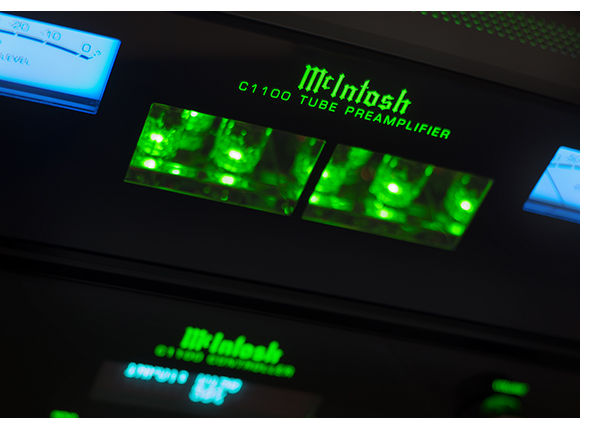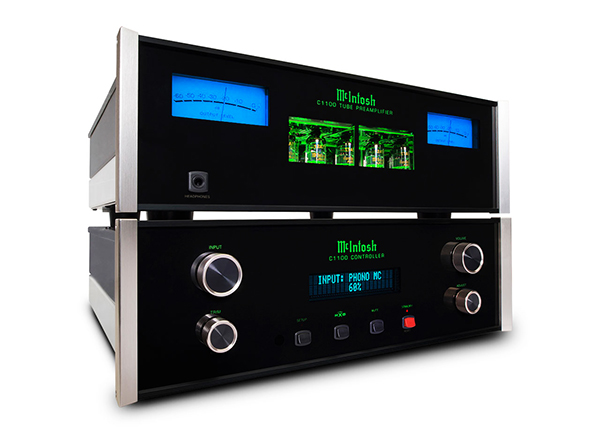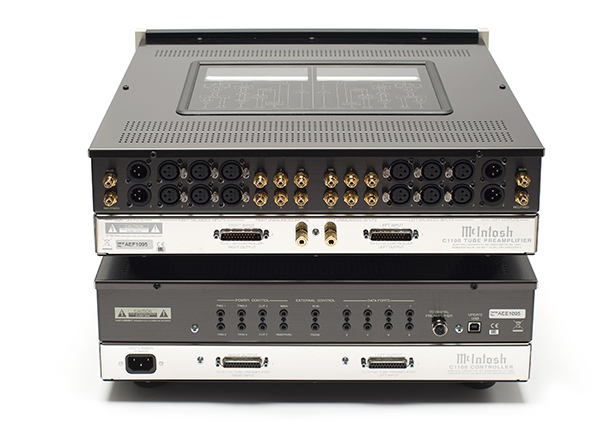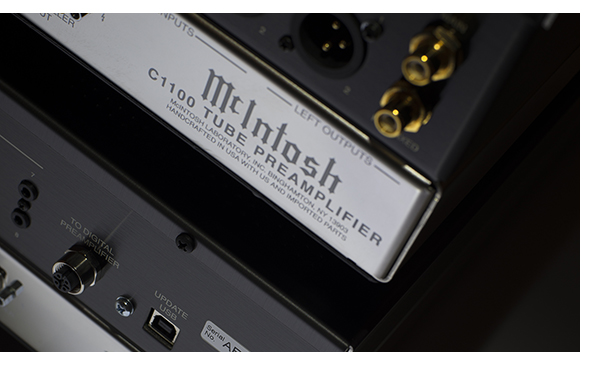McIntosh’s Flagship C1100 Tube Preamplifier Sets more than one benchmark!
By Jeff Dorgay Ubiquitous as the silhouette of the V-Twin engine on a Harley Davidson motorcycle, McIntosh Labs’ top products all feature a pair of blue output level meters, joined by a bright green, backlit glow of the controls adorning the thick glass-front panel.
Ubiquitous as the silhouette of the V-Twin engine on a Harley Davidson motorcycle, McIntosh Labs’ top products all feature a pair of blue output level meters, joined by a bright green, backlit glow of the controls adorning the thick glass-front panel.
Today that blue and green glow is modulated by LED lighting (instead of the incandescent bulbs of vintage Macs), meticulously adjusted by factory technicians so all of your Mac components glow with equal intensity and color temperature. Sitting down to listen to music in a dimly lit room of McIntosh gear always feels like sitting in a dark stadium, with only the glow of the Marshall amps and effects racks, waiting for the band to take the stage; it’s a visual celebration of audio in action.
Like their outgoing C1000 two-box preamplifier, the C1100 splits control and amplification functions across two chassis, offering higher performance and lower noise as a result of giving the power supply a bit of space from the sensitive gain stages. The C1000 took things further, offering the option of being configured with a solid-state or vacuum tube active stage, along with having the ability to control both! It had a whopping $27,000 price tag to match.
When was the last time you went to buy a new car and the new model offered more performance at a lower price? I thought so. Yet that’s exactly what McIntosh has done with the C1100. Dropping the price dramatically, now $13,000, the casework on the new model is somewhat more straightforward, but there is no mistaking it for anything but a Mac––though less visually embellished than the model it replaces. A chat with my favorite group of McIntosh enthusiasts finds them split right down the middle: half of them are put off by the simpler casework, feeling it doesn’t differentiate the flagship enough from the rest of the herd, and the other half loves the fact that the new C1100 is that much more approachable.
Quick comparisons: new vs. new
Fortunately, the C52 preamplifier, which is the next product down the line from the C1100, just happens to be here for photography with new writer Greg Petan’s review on page 88. A single box unit, the $7,000 C52 has a built-in DAC and eight tone controls along with a phonostage; it is aimed squarely at an entirely different user.
Having both side by side on the rack begs a head-to-head comparison providing an excellent opportunity to see what shakes out sonically for the extra dough. Though the C52 retains the slightly warm, tonally saturated sound that made McIntosh famous, it is all solid-state, so no glowing bottles here. While the C52 offers more functionality than the C1100, thanks to the onboard DAC, it’s no match for the massive soundstage, dynamics and “reach out and touch it”-ness that the C1100 provides.
As with any such choice, you must decide what your budget, system and rack will allow. If massive flexibility is your top priority, save a few bucks and go for the C52. Purists with a “take no prisoners” performance attitude will prefer the C1100 – along with the three-rack spaces it and a separate DAC will require. However, once you hear it, it will be tough to go back.
New vs. old
When the past C1000 arrived configured as a tube preamplifier, it utilized eight 12AX7 tubes: four for the phonostage and four for the linestage. The C1000, like the new C1100 (which uses 6 12AU7 and 6 12AX7 tubes) is a fully balanced design, to drive McIntosh, or anyone else’s balanced power amplifiers in that mode, but there is only one option – all tube. And for good reason – the current C1100 is quieter than even the solid-state version of the C1000. McIntosh’s Ron Cornelius just smiles, saying, “It’s the quietest preamplifier we’ve ever made, period. There just was no need to make two versions of this one.” Damn, this thing is quiet.
A quick call to a couple of my Mcbuds still in possession of C1000s makes for another impromptu shootout. It doesn’t take long for all to agree that the nod has to go to the newer piece in terms of overall sonics. The C1100 is a winner on every level. You’ll have to listen carefully, but on your favorite tracks that are either more sparsely arranged or more acoustic in nature, the C1100 has an ease and freedom from cloudiness that the C1000 can’t quite match. The three C1000 owners were on the fence concerning whether they would trade up, but all were intrigued and impressed with the C1100.
The more time spent with the C1100, the more you realize just how sonically unobtrusive this preamplifier is. Regardless of source and source configuration (RCA or XLR), it goes about its business quietly and confidently. Where its predecessor is a few molecules warmer tonally, the C1100, much like the current Sonus faber speakers, manages to achieve a similar feat of maintaining the depth and midrange palpability of legacy models, while exhibiting more dynamic impact and extension at both ends of the frequency spectrum.
Weaving through a number of solo male and female vocal tracks, this new preamplifier works its magic, doing better with subtle spatial cues as well, and those wanting to hear every bit of breath at the microphone will be highly impressed. McIntosh has really raised the bar on their gear in the last 5–7 years, steadily refining and improving the range. Thanks to the economy of the manufacturing scale they enjoy, their gear is much more reasonably priced compared to offerings from other manufacturers 30 years ago.
Not only is the linestage easily the equal of what else is available for $8,000–$10,000, the phonostage is also on par with what you’d probably pay $3,000–$5,000 for as well. But McIntosh is not, nor have they ever been, about the minimalist approach – this is a control preamplifier in every sense of the word. If you want HT bypass, have a pair of turntables and numerous line level sources on hand –– the C1100 may be one of the only games in town. With 12 analog inputs, you will never be short an input.
Back in black (vinyl)
Should you be a maniacal vinyl lover with a turntable/tonearm/cartridge combo worth more than the C1100, you will most likely still want an outboard phonostage. However if you are a casual to journeyman analog enthusiast, with a MM or MC cartridge in the $1,000–$3,500 range, you will be more than satisfied with the performance of the C1100’s internal phonostage. Of course there are exceptions to the rule, so resist the urge to press the argumentative email button right now.
Running the C1100 through its paces with a number of cartridges from the $500 Rega Elys 2, all the way up to the Koetsu Jade Platinum, proves highly palatable. The best feature of the C1100’s phonostage (in addition to the 79dB s/n ratio) is the loading options: 25, 50, 100, 200, 400 and 1000 ohms. A number of megabuck outboard phonostages don’t offer this flexibility, and this additional adjustability is where the C1100 really shines, making it a perfect match for cartridges like the Rega Apheta/Apheta 2, which require loading in the 25–50 ohm range to give their best performance.
On that note, the Soulines HDX Kubrick/Rega RB1000/Apheta 2 combination in for review was a perfect mate for the C1100, with the Apheta 2 loaded to 25 ohms, delivering a silky smooth presentation. The additional MM input makes the C1100 perfect for those with two turntables or two tonearms sporting an additional cartridge. The only limiting factor is 60dB of gain, which will eliminate the lowest output MC cartridges. Keep your cartridge’s output above .4mv and everything will be just fine.
Those preferring MM cartridges can also adjust input capacitance from 50 to 800pf in 50pf steps. This is often overlooked, and fine-tuning this aspect of a MM cartridge will deliver stunning results. That cartridge that you thought might have been a little dull or slightly bright can now be adjusted to perfection. These small touches throughout the C1100 are what make it more than a sum of its parts.
Head trip
Those needing to escape to the world of personal audio from time to time will appreciate the care that went into the C1100’s headphone amplifier. With an impedance selector for low (16–40 ohm), medium (40–150 ohm) and high (150–600 ohm) impedance headphones, everything you can think of can be accommodated. Running through about a dozen phones, new and old, confirmed this claim. Whether I was listening to my ancient Koss Pro 4AAs or a pair of the latest planar magnetic from OPPO, the C1100 shines.
If you spend more than a few fleeting moments with headphones on, you’ll appreciate the Headphone Crossfeed Director (HXD®), which can slightly blend the right and left channel of the amplifier’s output, minimalizing the “ping pong” effect that comes with some recordings. This one is strictly a “to taste” function, making the headphone delivery sound more like a pair of speakers in front of you, mimicking that imaging pattern.
Listening to the classic headphone favorite Dark Side of the Moon with HXD engaged keeps the soundstage more linear as promised, especially on “Time”; the alarm clocks stay more within a boundary, yet without, they appear to bounce all over the room. Tidy or trippy, that’s the question. Fortunately, experimentation is only a button push away.
If all of this weren’t enough, perusing the excellent user manual reveals how truly flexible the C1100 is. Need home theater bypass? Got it. Want to trim all of your input sources so the volume level is the same? Got that too. And that’s only scratching the surface of what the C1100 is capable of.
The McIntosh C1100 handily offers sonic and build quality commensurate with the asking price, but what puts it in a category of its own is the convenience that it offers. Those wanting a volume control and power switch only will not be the least bit interested, but those with multiple sources wanting high quality playback for all with easy integration will be in hifi heaven. Don’t forget those blue meters, either.
If you are new to the McIntosh tribe, looking for a step-up from what you currently have, or even looking at $13K (or thereabouts) preamplifiers in other camps, the C1100 is outstanding. The phonostage is incredible, as is the headphone amplifier. You’d be pretty hard-pressed to find a linestage, phonostage, or headphone amplifier along with two additional power cords and interconnects that would match the performance of the C1100, as well as the rack space the rest of this stuff would require for anywhere near $13K.
Factor in reputation, dealer support and all the other things that make a Mac a Mac, and the C1100 is a fantastic preamplifier any way you look at it. Highly recommended if you are a lover of the brand, and if you aren’t, this is the perfect piece to start your journey.
 The McIntosh C1100 Preamplifier
The McIntosh C1100 Preamplifier
$13,000
Peripherals
Analog source Brinkman Bardo/Koetsu Jade Platinum, Soulines Kubrick/Rega Apheta 2, Rega Planar 3/Elys 2
Digital source Gryphon Kalliope DAC
Amplification ARC GS150, CJ LP125sa+, Pass Xs 300 monoblocks
Speakers GamuT RS5i, Quad 2812, MartinLogan Neolith
Cable Tellurium Q Silver Diamond




